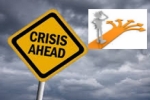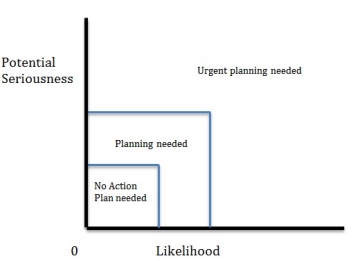Unilever recently released their annual report in which they used their new acronym ‘VUCA’ to describe how they see the international environment in which they work: Volatile, Uncertain, Complicated and Ambiguous.
One of the points we can take from this is that as human beings we are often pretty poor at predicting the future. How many of us who were watching expected Ukraine to go off as it did, and for Putin to leap into Crimea just days after the change of government? How many of us saw the Arab Spring coming?

The same can apply to the UK business environment. How many of us six years ago expected that the Scots would be voting on independence? How many of us can say we saw the 2008 Financial Crisis coming in time to be fully prepared for it? So many businesses barely have enough time to plan a few years in advance, particularly small businesses, let alone prepare a crisis management plan for when things go wrong.
Preparing for the future and identifying threats are things we all have to try to do, and one method was made famous by Donald Rumsfeld’s three categories:
- The ‘Knowns’ (the things we know)
- The ‘Known Unknowns’ (the things we don’t know of, but at least we realize we don’t know of them)
- The ‘Unknown Unknowns’ (the things we don’t even realize we don’t know)
We should all try to identify the ‘Knowns’. If things go wrong because we ignore those, we have only ourselves to blame.
We should make an effort to identify the ‘Known Unknowns’, as they should be the uncertainties that bug us but that we can do something to clarify. If we can’t work out where the ‘Known Unknown’ threats will come from exactly, we should at least try to identify the vulnerabilities in our businesses to give us an idea of how we could be affected.
Carrying out an exercise like this can also help to translate potential ‘Unknown Unknowns’ into ‘Known Unknowns’. Previously unconsidered threats come to mind and the business benefits.
From this, we can create a crisis plan. It may not be a plan as such, more a map of all the vulnerabilities the business could face. It may even involve a simple graph-like structure identifying the likelihood of threats against their potential seriousness:

In business there’s often a direct impact on the workforce, so many reactions will involve delving into employment law and HR. Workforces may have to be re-trained or reduced, or sites shifted or even lost. Managing the workforce should be an integral part of any crisis plan.
A few examples of crises to plan for might be:
- Raw material supply disruption (ferry strike in France?)
- Transport disrupted by environmental factors (volcanic ash cloud or a harsh winter)
- A new competitor arising (coffee shops v Waitrose free coffee)
- Energy problems (do you need a generator?)
- First-time industrial action due to political changes
- Sudden demand for a better-trained workforce by a client
- Another financial crisis affecting traditional customers
- Sudden change in case law causing a back log of equal pay claims
- The British public gets fed up with centre-ground political parties and votes greater power to the more extreme parties who advance radical and unexpected changes in the law
Once carried out your plan may hardly ever be looked at. It may sit on the shelf and only get reviewed and update once a year, or when a potential threat appears in the news.
But once it exists, it is then much less effort to revisit it with updates. When an unexpected disaster strikes, it is much more comforting to have some sort of guide with information and predictions for scenarios to work from. It won’t be perfect, because the disaster will almost certainly have an unexpected ‘VUCA’ twist, but it will help you to gather your thoughts and react more quickly.
Russell HR Consulting provides expert knowledge in HR solutions, employment law training and HR tools and resources to businesses across the UK.
Subscribe to our free monthly HR newsletter. Russell HR Consulting employment law newsletters are emailed automatically to our ever-growing number of subscribers every month.
Latest blog posts
- Is There a Santa Clause?
06 / 12 / 2023
- Lend Us a Hand!
22 / 11 / 2023
- What Happens When There is a Clash in Protected Characteristics?
17 / 10 / 2023
- Encouraging a Healthy Workforce 2
21 / 09 / 2023
- Encouraging a Healthy Workforce
23 / 08 / 2023
- What a Disaster - (But We Have a Cunning Plan!)
20 / 07 / 2023
- It’s Time We Stiffened the Sinews
14 / 06 / 2023
- Why Is It So Important to Develop Emotional Resilience?
16 / 05 / 2023
- When is a discretionary bonus not discretionary?
20 / 04 / 2023
- Recovering Training Costs 15 / 03 / 2023
